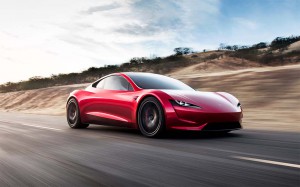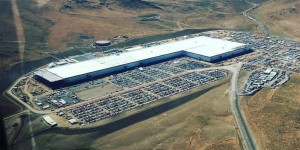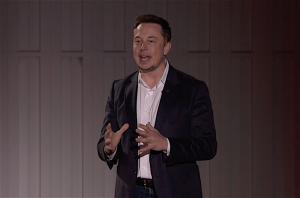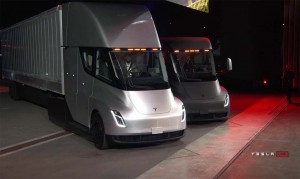
Forget those earnings numbers. Tesla CEO Elon Musk was far more interested in talking about future products, the next-gen Roadster shown here.
Tesla CEO Elon Musk is not one to suffer fools – or critics – lightly, as he proved during a 75-minute teleconference call following the release of the automaker’s first-quarter earnings report on Wednesday evening.
The South African-born executive attempted to put a positive spin on what was Tesla’s worst-ever quarterly deficit, promising future earnings while also revealing plans for new factories, new products and a new, fully hands-free version of the Autopilot system. But Musk also offered a harsh assessment of some of the reporters on the earnings call, while repeatedly cutting off analysts looking for long-term financial projections that he dismissed as “boring.”
“These questions are so dry, they’re killing me,” he interjected before dismissing one analyst’s questions. Musk later shifted his disdain to reporters, at one point suggesting that by questioning the safety of Tesla’s current, semi-autonomous version of Autopilot, reporters might convince drivers to turn it off “and then die.”
(For more on Tesla’s first-quarter earnings, Click Here.)
Despite his most optimistic comments, Musk’s edginess helped reverse the initially upbeat response to Tesla’s record, $784.6 million, or $4.19 a share, loss – which was actually a bit better than Wall Street’s consensus forecast. Shares surged after the earnings were released, but then tumbled sharply, quickly wiping out almost $2 billion in market capitalization.
Tesla’s stock has a history of taking roller-coaster rides, and it’s far from clear how it will perform once analysts and investors work past the slights of the earnings call and shift to the substance of what Musk actually had to say when he responded to questions.
Some of the key issues focused on the immediate problems related to the Model 3 roll-out which is well behind schedule – or in Musk-speak, facing a “time shift.” He noted “production is improving dramatically, exponentially, in fact.” It hit about 2,000 vehicles a week by the end of Q1 and the target is 6,000 by mid-year.
(What’s really under the skin of the Tesla Model 3? Click Here to find out.)
It will be critical to get on track, though the company really has to reach 10,000 cars a week to meet its original forecast, and to avoid the financial catastrophe that is leading many to now short Tesla stock. But Musk was nothing but upbeat, insisting he is “definitely confident” Tesla will not only be in the black and delivering positive cash flow by year-end but delivering 20% profit margins.
As financial questions started parsing the details, Musk started cutting off questioners until he found one who was clearly in his camp and suddenly, the one-question/one-follow-up rule went out the door. But the subsequent conversation did elicit some intriguing information on future products and production plans:
-
Investments in the Model Y, an SUV counterpoint to the Model 3, will ramp up next year, and the battery-ute will reach showrooms about 24 months from now – assuming Tesla can meet that target;
- The troubled Fremont, California assembly plant is “jammed to the gills,” Musk said, so Model Y likely will get its own, new plant;
- But Tesla may first open a plant in China, the world’s largest car market and a place where EV sales are booming;
- Both the Chinese plant and the Model Y factory will combine vehicle and battery production. No more separate Gigafactory battery plants and assembly plants, Musk said;
- The Model Y, he added, will usher in “a manufacturing revolution,” using what the company learned from the Model 3, “because we don’t want to go through the same pain again”;
- Musk also suggested that the planned heavy-duty Semi truck would deliver about 600 miles of range per charge, 20% more than was promised when it was unveiled last autumn.
Musk also dismissed as both “laughable” and “absurd” a lawsuit filed against Tesla by a Salt Lake City company, Nikola Motors, which is building its own green truck, this one powered by long-range hydrogen fuel-cells. Nikola claimed in its filing that Tesla had illegally copied patented elements of the start-up’s Nikola One truck.

Future Tesla plants will combine the battery production of the Gigafactory, shown here, and vehicle assembly operations.
(Does Tesla Semi live up to the hype? Click Here for more.)
Separately, Musk predicted that big rigs like the electric Semi will have a dramatic shift on the freight business, especially when fully autonomous technology comes of age, allowing trucks to “platoon,” or travel down highways nose-to-tail, much like railcars. That “will quite dramatically impact (the revenues of) the train industry,” he said.
Tesla was one of the first automakers to offer semi-autonomous technology with the launch of its Autopilot system, and Musk said a fully hands-free version, “from a technical standpoint might be ready by the end of next year.”
But Autopilot has generated a fair bit of controversy, and the National Transportation Safety Board is now probing a recent, fatal California crash that occurred while a Tesla Model X was being operated in Autopilot mode.
Musk kicked off a storm when he criticized the driver who, according to Tesla, failed to take control of the vehicle, ignoring warnings from the Autopilot system. The South African-born exec waded even deeper into controversy during the Wednesday conference call, directly challenging critics of autonomous technologies, including Autopilot.
“It’s really incredibly irresponsible for any journalist with integrity to write an article that would lead people to believe that autonomy is less safe — which might lead people to turn it off and then die,” Musk declared.
Tesla will move forward on the development of Autopilot, he said, asserting that autonomous vehicles will eventually deliver a sharp reduction in the crashes that are estimated to kill as many as 1.25 million people a year worldwide – more than 40,000 of those in the U.S. alone.
Musk’s critics contend that it isn’t an either/or situation. There are active proponents of autonomous technology who also question whether the systems now being tested on public roads are ready for prime time. They point not only to the Tesla Model X crash but a fatal incident involving an Uber prototype operating near Phoenix.
In a previous fatal crash, the NTSB held Autopilot at least partly to blame. It could take another year before a final report on the recent California crash is released. But further criticism of Tesla’s technology could add to an assortment of woes the company is facing, not the least being its Model 3 production problems.


